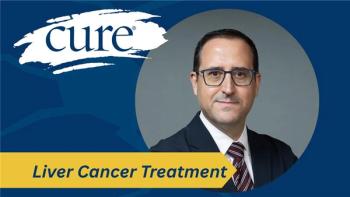
Metastatic Breast Cancer Heroes™
- CURE® Metastatic Breast Cancer Heroes™ 2021 Essay Book
- Volume 1
We Don’t Need More Pink Ribbons for Breast Cancer — We Need Treatments and Hope

A mother writes about her daughter — a nurse with metastatic breast cancer who passionately cares for patients even while undergoing chemotherapy — and how more treatment options are desperately needed.
The following is a short unfolding of the story of my daughter Brandi’s journey, first with breast cancer, then with metastatic breast cancer.
It was written by Brandi herself, as she was asked to tell her story at Florida Cancer Specialists, where she is an RN, helping patients adjust to the words “you have cancer” every day. She is a hero in their eyes and a living example of what the word “hope” means.
While the words may be lengthy, it shows hope and perseverance at the time when she was faced with the worst news in her life. It is my hope that it will also show hope to others.
It started 11 years ago ...
Written by Brandi Riber, October 2020: “My breast cancer journey began in July 2009. I had just graduated from nursing school and was beginning the job of my dreams of becoming an oncology nurse. I also had a sweet little girl who was 3 years old. I had noticed a lump on the outside of my left breast and went to my ob-gyn, and was reassured that he didn’t feel it was anything, but I was also given a script for anultrasound and a biopsy in case I felt it necessary. I delayed getting the testing done, as I did not feel overly concerned. Until I did ...
I was getting out of the shower one day and noticed a dimpling area on the outside of my breast where the lump was. This is kind of when it all becomes a blur, but I do know that I immediately went for that ultrasound and a biopsy was performed. The next thing I know, I was being told that I would need to meet with the surgeon and oncologist to discuss the next steps. I was diagnosed with infiltrating ductile adenocarcinoma stage 2b on January 4, 2010.
I had my first surgery in January: left side mastectomy with 17 lymph nodes removed, three positive, and a mediport placed for treatments. I had my first chemotherapy on January 22, 2010, a total of six treatments, one every three weeks. I will never forget how tough the treatments were or how much support I had around me at that time to get me through.
I had my last treatment and rang the special bell my own father made on May 7, 2010. Continuing treatment consisted of five years of oral hormonal treatment; however, I was deemed cancer free! I opted to have a double mastectomy with my final reconstruction 11 months from my diagnosis, on December 3, 2010.
I continued the normal monitoring along with the oral treatment and in November 2014, just months shy of the magical five-year mark, I was first diagnosed. This time it was stage 4. The cancer had spread to my liver and some small areas in my sternum. My world had once again been turned upside down.
Although I had a very low chance of recurrence — less than 18% — the next course of action was to have my ovaries removed and a biopsy of the liver to confirm that it was in fact the same type of cancer that had recurred. Fortunately, it was confirmed to be the same type of cancer, and this began my metastatic journey. I was fortunate to be accepted into a clinical trial, and my oncologist was hopeful with this new medication as it showed promising results. I started the new trial therapy in December 2014. This was a double-blinded trial, meaning I had no idea if it was the drug or a placebo I was receiving each month. Soon the scans showed improvement and around the 18-month mark, I was in remission. I continued the study for 64 cycles, which is just over five years, before I progressed again in October 2019. The trial drug I had taken has since been approved by the FDA and is now a regimen used as a standard of care for many patients in my situation.
I have since progressed four more times. With each progression a new treatment regimen was started, three of the four being clinical trial studies. During this time, my dental health had deteriorated due to the side effects of long-term use of oral medications. This led to another long journey that currently continues. I have had all my teeth removed and replaced with dental implants. Support was again given to me by family, friends and the generosity of dental professionals to help cover costs along the way.
With my current recurrence just over a month ago, my scans again showed progression in the bones and liver. With the end of another trial study, I have now begun a new clinical trial for IV chemotherapy. I started this new regimen the day before my little girl turned 13 on September 11, 2020. And life goes on ... again, with the support of family and friends, for which I am eternally grateful.
Brandi wrote this in October 2020. As of October 2020, she has now progressed well past the many more drug trials that she tried, at least five more recurrences since she wrote this; we have lost track. A recurrence and end of a trial drug occur when the scans show increased activity and involvement instead of shrinking. Never good news, it just means more lesions and new growth, not what anyone wants to hear. Just when she thought that this trial would be the one to help, her hopes were shattered by the news that she would no longer be on the trial. A trial is good and kept in place only if an improvement is seen. She is now out of trials and on chemotherapy once again.
However, Brandi’s story is one of hope. Eleven years and counting is a very long time to “do” breast cancer. Having metastatic breast cancer for the last seven years is almost unheard of.
Before Brandi had breast cancer, I did not know that no one dies of breast cancer; one dies from metastatic breast cancer — cancer that has spread to vital organs. Once that occurs, there is no cure, but as you just read, there is hope. We need funding for metastatic breast cancer studies.
We need new trial drugs to be invented. We need more hope. Wearing a pink ribbon no longer is enough.
My daughter Brandi just celebrated another year and her reason for living. You read that her daughter Morgan had turned 13 when she began another study, and on September 11, 2021, Morgan and her mom celebrated birthday No. 14. And for that, we are all blessed and grateful beyond words.
Someone will hear the words “metastatic breast cancer” and hopefully, if they read this about my amazingly strong and warrior daughter, they will have hope.
What you don’t understand and Brandi doesn’t say is that she has missed very little work from the time of her diagnosis. She lives to be at work to educate and show extreme compassion and commitment for her patients. Currently, while she is hooked to her chemo line, she continues to be present at work and doing her job, literally while the drug runs through her veins. She is a vision of hope to the patient who has more questions than they know what to ask and gives firsthand knowledge because she is living it.
Thank you for reading Brandi’s story. She is a wonderful nurse who leads a life to help others deal with cancer and a mom who loves her child more than you can imagine.
For more news on cancer updates, research and education, don’t forget to
EDITOR’S NOTE: Brandi Riber, RN, died shortly after the Metastatic Breast Cancer HeroesTM awards program in December 2021. Our thoughts go out to her family and friends.
Articles in this issue
over 3 years ago
Passion and Persistence in the Face of Metastatic Breast Cancerover 3 years ago
Ending Metastatic Breast Cancer for Everyoneover 3 years ago
Compassionate Guidance Through a Cancer Clinical Trialalmost 4 years ago
Turning Sorrow Into Joy: The Oncologist Who Gave My Life Back




